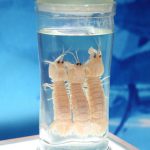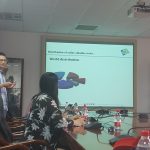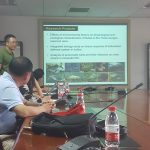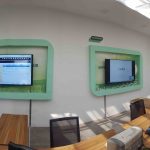Blog Entry Written By Team: Golden Rod
Team Members: Ernest Hon-Hin Yeung (Queen’s), Mengze Zhang (Waterloo)
Weather: Sunny in the morning and a bit cloudy in the afternoon
Today is our final day visiting the GongHureconstructed wetland & TaiHu conservation area in Wuxi. Luckily, there was a nice breeze due to the rain in the early morning that had a wonderful cooling effect. We arrived at the GongHu Conservation Museum and began a discussion entered on seven key topics.
We first has a brief introduction to the GongHu reconstructed wetland. The GongHu wetland is one of several famous spots for tourists and is providing students with many different learning opportunities, while enhancing knowledge of the importance of ecosystem protection to the local people.
Second the museum shows the relationship between TaiHu and GongHu. TaiHu is the second largest lake in China (by area) and GongHu is situated at the opening for water from Yangtze river which flows into TaiHu. TaiHu is also one of the main water sources for citizens of Wuxi. There was a map in the museum showing the direction of water flow from the Yangtze river through to Shanghai.
The third theme covered by the displays was environmental management in TaiHu. Water quality of TaiHu in previous years was so poor that it caused serious algal blooms, affecting water quality for millions of citizens. This caught the attention of the provincial and central government which lead to more active environmental management, and closing of many fishponds and factories in the surrounding areas.
There were also displays showing the ecological composition of GongHu wetland, including the array of species that reside in the wetland, other displays pertaining to to training and technology (e.g. data showing how plants play a significant role in such wetland locations).
The final theme focused on how one could use different technology to perform real time detection to manage the quality of water in the wetland – with a possible vision for management plan and future directions for improving the overall water quality of all of TaiHu. This visit allowed us to develop a deeper understanding on the history of TaiHu, how different strategies and methods are being established and applied, and also how anthropogenic activities greatly affect the environment. We must recognize humans impinge on the ecosystems and resolve issues before they have catastrophic consequences for both humans and nature. Habitat reconstruction of degraded habitat and active conservation pf species and ecosystems are pivotal.
In the afternoon, we arrived at the East China Sea Fishery Institute & Museum. First Dr. BoJian Cheng gave a lecture about a few research projects that he has done such as the effects of environmental factors on physiological and ecological characteristics of fishes in the Three Gorges reservoir area, stress response of antioxidant defense system in turtles and how personality traits affect the mate choice in several mosquito fish. One interesting fact from Dr. BoBo Chen was that the morphological plasticity grants the possibility for some fishes to change their capillary surface area under different temperatures; this process is also reversible. Furthermore, we learned that fish also have personality traits like boldness, activity in open water body and their sociability. These three indicators, along with physical characteristics like body size could affect their mating preferences to or toward others. After this, another speaker Dr. Zongli Yao gave a lecture about physiology of aquatic animals acclimated to saline-alkaline water. This type of habitat is very fragile and is very sensitive to both climate change and human activities like hydrological engineering. He also shared some of the different adaptations fish can have under these kind of saline-alkaline water environments.
After these wonderfully-informative lectures, we went to visit one of labs inside the institute which studies how different types of fishing trawlers would affect the aquatic environment and how to enhance the life-time of fishing nets.
We also visited the museum collections with myriad archived specimens. Many species housed in the collections would not be seen in our daily lives, including the Chinese sturgeon (Acipenser sinensis), Ocean sunfish (Mola mola), and the skeleton of a baby whale. One of the species we found most interesting was from the Siganoidei fish family – the species is omnivorous preying on diatoms and algae and some have suggested that might be useful as a partial solution to algal blooms caused by eutrophication. However, since this kind of fish only lives in sub-tropical water and most algal blooms happen in the northern parts of China, the suggestion is probably not feasible.
Last, we visited the museum of fisheries tools and ships. This museum shows different techniques that can be used in fisheries, type of fishing tools being used in different parts of China, and different types of fishing nets and boats we would normally see.
The visit to the institute has given us some idea and understanding for current studies related to aquatic organisms and fish. Additionally, through our visit to the archive, it has shown us how diverse the aquatic organisms can be, how species can adapt to different environments through different techniques, morphologically and through behaviours. At last from the fisheries tools museum, it showed us how closely human and marine organisms are related to each other from a long time ago. This visit enlightened us on the importance of conservation for aquatic ecosystems.
今天是在贡湖湿地学习的第四天,昨天下过雨后今天的天气有些舒爽,不再那么炎热。
早上我们来到贡湖湿地博物馆参观学习。博物馆一共分为七个部分,第一个是介绍贡湖湿地的情况,贡湖湿地是无锡的一张名片,为中小学生提供学习的机会,提高市民保护水的意识。第二部分是太湖与贡湖的关系,太湖是中国第二大湖,贡湖是太湖流入长江的入水口,并且太湖是无锡城市的主要用水来源,还有一张地图展示了上海苏州和无锡在太湖的位置关系。第三部分是太湖的环境治理,太湖曾经水质特别差,经过一系列的治理包括退塘还湖,建立示范区等措施将贡湖湿地的水质保持在了四类水。第四部分讲了贡湖湿地的介绍,包括湿地中的植物标本,鸟类等,我们还看到了一些标本。第五部分讲了组培技术,介绍如何研究贡湖湿地植物。第六部分讲课如何在线监控贡湖湾湿地的状况,包括在线监控显示屏,湿地检测的内容等。最后一个部分就是总结,和要达到的理想状况。通过参观博物馆我们了解到了太湖的过去和治理的流程和方法。感觉人类的活动对水质和生态环境的影响很大,但是后期的生态修复的进展也很明显。
中午出发去上海继续我们的学习。
下午我们来到东海 水产研究所进行学习。首先由Bo Jian 老师给我讲了他做的一些研究项目,环境因素对生理和生态特征的影响,三峡库区鱼类的应激反应在海龟的抗氧化防御系统和个性特征如何影响G. affinif 的配。BoBo Chen博士又提出的一个有趣的事实,形态学的可塑性使得一些鱼类在不同温度下改变它们的毛细血管表面积成为可能;这个过程也是可逆的。此外,我们还了解到,鱼还可以在开放水域活动和社交。三个指示的方式包括体型,身体特征可能会影响他们对他人交配得偏好。之后由姚老师给我们讲了一场关于水生动物适应盐碱水生理学的讲座。这种栖息地非常脆弱,对气候变化和水文工程等人类活动都非常敏感。他还分享了鱼在这种盐碱水环境下的一些不同适应性。讲座结束后我们来到渔网强度实验室,研究不同种类的捕捞爬虫会如何影响水生环境,以及如何提高渔网的寿命。
我们还参观了水生生物标本的档案。这个档案馆收藏了大量不同种类的资料。它们中的许多在我们的日常生活中是看不到的,包括中华鲟(中华鲟鱼)、海洋翻车鱼(翻车鱼)和一条幼鲸的骨骼。我发现一个有趣的物种是Siganoidei,它是一种杂食动物,以硅藻和藻类为食。有些人认为它们可以用来治疗因富营养化而引起的藻华。然而,由于这种鱼只生活在亚热带水域,而且大多数的藻华发生在中国的北部地区,所以这种说法是不可能的。
最后,我们参观了渔具和渔船博物馆。这个博物馆展示了在渔业中使用的不同技术,中国不同地区使用的渔具类型,以及我们通常看到的不同类型的渔网和渔船。
通过在这里的学习,我们对目前有关水生生物和鱼类的研究有了一定的了解和认识。此外,通过参观东海鱼类博物馆,我们了解了水生生物的多样性,以及物种如何通过不同的技术、形态和行为来适应不同的环境。最后,通过参观渔业工具博物馆,我们知道了很久以前人类和海洋生物之间的密切关系。这次访问使我们认识到保护水生生态系统的重要性。






Leave a Reply